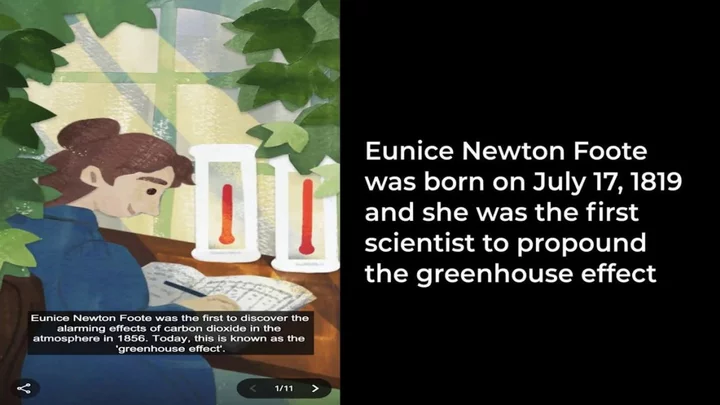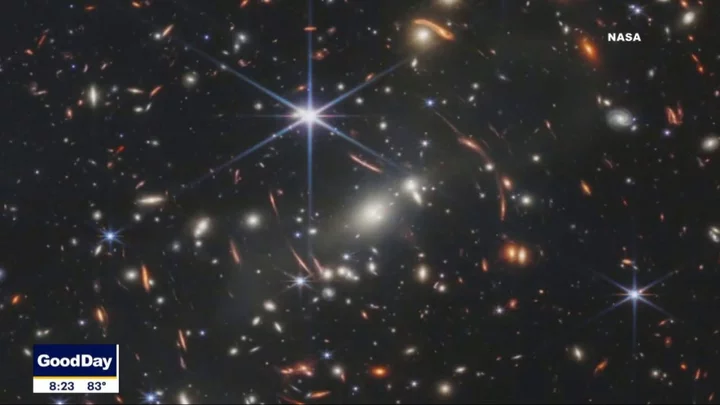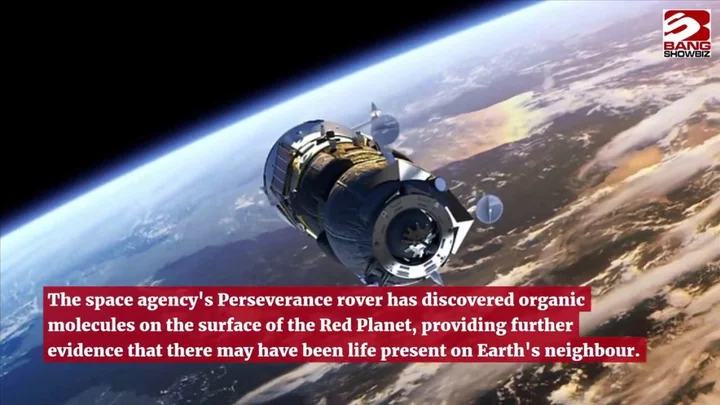
South Korea’s LG Unveils AI Software for Use Across Its Units
South Korea’s LG Group introduced an upgraded version of its artificial intelligence software, and demonstrated how it can
2023-07-19 13:18

Amazon Says Its Carbon Emissions Fell for First Time Last Year
Amazon.com Inc.’s carbon emissions ticked lower for the first time since the company began reporting the figure, thanks
2023-07-18 21:56

The iNaturalist App Is Like Shazam for Plants, Animals, and Insects
It has even led to the discovery of a new species.
2023-07-18 05:26

New technique represents major breakthrough in search for aliens, scientists say
A new technique is a dramatic breakthrough in the search for alien life, astronomers say. Researchers at the Breakthrough Listen project based at the University of California, Berkeley say they have developed a new way to be sure that any potential signal is really coming from space – and not from something more boring. Astronomers spend vast amounts of time looking for radio signals that might have come from alien civilisations as part of work on the search for extraterrestrial intelligence, or SETI. But they have in the past been fooled by very human technology, such as cellphones, microwaves and car engines, that can produce a blast of radio signals that look as if they have come from distant worlds. One way to check whether signals are really alien is to point the telescope elsewhere and then repeatedly return to the same spot, with the hope of seeing the signal again and ensuring that it is not a false alarm. But that is not foolproof – and only works if the signal sticks around. Some of the most promising radio signals might only be detectable once. The so-called “Wow!” signal, for instance – a radio signal detected in 1977 that was so shocking the astronomer who found it wrote the exclamation on a printout – has not been detected since, and astronomers still do not know whether it was an alien message or just a mistake. Now scientists have devised a new test that can be used to see whether a signal has really passed through interstellar space, which should help show that it is not from elsewhere on Earth. It works by looking for “scintillation” – the changes in amplitude of a signal as it is affected by the cold plasma of space. “The first ET detection may very well be a one-off, where we only see one signal. And if a signal doesn’t repeat, there’s not a lot that we can say about that. And obviously, the most likely explanation for it is radio frequency interference, as is the most likely explanation for the Wow! signal,” said Andrew Siemion, principal investigator for Breakthrough Listen and director of the Berkeley SETI Research Center, which operates the world’s longest running SETI program. “Having this new technique and the instrumentation capable of recording data at sufficient fidelity such that you could see the effect of the interstellar medium, or ISM, is incredibly powerful.” Dr Siemion called the breakthrough “one of the biggest advances in radio SETI in a long time” and said that it would be the first time researchers would be able to differentiate a real signal from a false alarm, even if it was only detected once. The technique can only be used for signals that have travelled 10,000 light years or more to Earth, researchers note. If it was closer to us, the scintillation effect cannot be seen because they are not travelling through enough of the interstellar medium, or ISM. The research is described in a new paper, ‘On Detecting Interstellar Scintillation in Narrowband Radio SETI’, published in The Astrophysical Journal. Read More Battery breakthroughs are about to trigger a transport revolution Huge asteroid nearly crashes into Earth – and is only spotted days later ChatGPT rival with ‘no ethical boundaries’ sold on dark web
2023-07-18 00:16

Scientists are one step closer to creating a bonafide time machine
They may not be as stylish as a DeLorean or as sturdy as a blue police box, but wormholes in space could hold the key to real-life time travel – and a team of experts think they’ve figured out how. The trio of scientists delved deep into the laws of physics and discovered that it might be possible for humans to one day zip across galaxies in a matter of seconds, or journey through time itself. Now, this is all to do with the general theory of relativity and quantum physics, so don’t expect to get your head around it too easily. However, in their paper, Valeri P. Frolov and Andrei Zelnikov of Canada’s University of Alberta, and Pavel Krtouš of Prague’s Charles University proposed that a specific kind of wormhole would “inevitably” be “transformed into a time machine” if it was subject to particular conditions. Sign up for our free Indy100 weekly newsletter For the uninitiated, wormholes can be described as spacetimes in which a “kind of tunnel exists connecting distant parts in the universe”. The main problem with them is… they don’t actually exist. At least not in any tangible way. As Drs Eric Christian and Louis Barbier put it in an explainer for NASA: “Wormholes are allowed to exist in the math of ‘General Relativity’, which is our best description of the Universe. “Assuming that general relativity is correct, there may be wormholes. But no one has any idea how they would be created, and there is no evidence for anything like a wormhole in the observed Universe.” Still, numerous experts in the field of gravitation and general relativity have spent years or even decades working on them, including Stephen Hawking in his time. For their paper, Frolov, Krtouš, and Zelnikov explored what is known as a ring wormhole, which was first described in 2016 by theoretical physicist Gary Gibbons, of Cambridge University, and Mikhail Volkov of the University of Tours. Unlike the spherical contortions of spacetime we might attribute to black holes, the ring wormhole proposed by Gibbons and Volkov connects sections of the universe (or, indeed, different universes) which are generally described as “flat”, as ScienceAlert notes. Ring-shaped masses could potentially create some pretty remarkable distortions in what would otherwise be flat spacetime if you consider how their electrical and magnetic fields might interact. And so Frolov, Krtouš, and Zelnikov decided to consider two types of such wormholes: “a wormhole connecting to flat spaces; and a wormhole connecting two distant domains in the same space”. For the latter, they concluded that if a “massive thin shell” surrounded one of the mouths of the ring wormhole, a “closed timelike curve” would form. This, as the name suggests, would mean that any travelling object (or ray of light) would come back to the exact same point whence it began. In other words, you could travel in space and time and return to your point of departure. The most exciting aspect of ring wormholes, as the authors point out is that: “For the ring wormhole an observer passing through it moves in a flat (or practically flat spacetime), while in the case of ‘standard’ (spherical) wormholes he/she should pass a domain filled with the matter violating the null energy condition.” Even without knowing what the “null energy condition” is, you can appreciate that the first option sounds a lot simpler. Now, before you start calling yourself Marty McFly or making a list of all the past mistakes you’d like to correct, we should stress that we’re a long way off seeing the creation of a bonafide, buckle-your-seatbelt time machine. But at least, thanks to the efforts of experts like Frolov, Krtouš, and Zelnikov, we’re at least one step closer to going back in the future. Have your say in our news democracy. Click the upvote icon at the top of the page to help raise this article through the indy100 rankings.
2023-07-17 20:18

Who is Eunice Newton Foote? The scientist celebrated in today's Google Doodle
We talk about climate change and the devastating effects of greenhouse gases on a daily basis, yet many of us have never heard of Eunice Newton Foote. The American scientist was the first person to realise the alarming impact of carbon dioxide in the atmosphere, all the way back in 1856. So, to mark what would have been her 204th birthday, Google has dedicated today’s Doodle to the environmental pioneer. Head to the search engine and you’ll find an 11-part slideshow explaining Foote’s most significant work. Sign up for our free Indy100 weekly newsletter It goes on to point out that her research was largely ignored for almost 100 years, and credits her with being the first person to “plant a seed of interest in the issue of climate change”. And for anyone wondering, her surname is no coincidence: her father was allegedly a distant relative of Sir Isaac Newton. In a blurb to its Doodle, Google points out that whilst science was Foote’s lifelong passion, she also dedicated time to campaigning for women’s rights. In 1848, she attended the first Woman’s Rights Convention in Seneca Falls, New York State and became the fifth signatory of the Declaration of Sentiments — which demanded equality for women in social and legal status. Back then, women were largely shunned from the scientific community, but this didn’t stop Foote from conducting experiments on her own. After placing mercury thermometers in glass cylinders, she noticed that the cylinder containing carbon dioxide heated up the most and took the longest to cool down. As a result, she became the first scientist to draw a connection between rising CO2 levels and the warming of the atmosphere. After publishing her findings, Foote wrote a second paper on atmospheric static electricity for the journal ‘Proceedings of the American Association for the Advancement of Science’. These were the first two physics studies to be published by a woman in the US, as Google notes. In 1856, a male scientist presented her work at the annual meeting of the American Association for the Advancement of Science. This then lead to further experiments which uncovered what is now known as the Greenhouse effect. And whilst none of us relish the fact this phenomenon exists, we should be eternally grateful to Foote for flagging it to us, all those years ago. Have your say in our news democracy. Click the upvote icon at the top of the page to help raise this article through the indy100 rankings.
2023-07-17 15:46

How one lake has captured the moment we changed the world forever
The floor of Crawford Lake in Ontario acts like a storybook, preserving Earth’s recent history in chronological order. Crawford Lake reveals the activities of local Iroquoian communities from the late 13th to 15th centuries, all the way through to the present day. This is because Crawford Lake is a meromictic lake, meaning that the dense bottom layer of water does not mix with the less dense upper layers. “The isolated bottom layer of water remains under disturbed, enabling the accumulation of clearly laminated valves which record precise information about the time during which they were deposited,” according to the Anthropocene Working Group. Experts have nominated Crawford Lake as representation for the start of the Anthropocene epoch, a proposed new geological era characterised by significant changes to the planet’s surface as a result of human behaviour. The Anthropocene is yet to be officially accepted as a unit of geologic time, but in 2016 a working group under the guidance of an International Commission on Stratigraphy subcommittee agreed that human behaviour has left scars so deep that they will remain evident even into the distant future. Sign up to our free Indy100 weekly newsletter One of the most notable markers of the Anthropocene is the appearance of plutonium, a radioactive material that appeared in the mid-20th century as a result of hydrogen bomb tests. “The presence of plutonium gives us a stark indicator of when humanity became such a dominant force that it could leave a unique global ‘fingerprint’ on our planet,” explained Professor Andrew Cundy, Chair in Environmental Radiochemistry at the University of Southampton and member of the Anthropocene Working Group. “In nature, plutonium is only present in trace amounts. But in the early-1950s, when the first hydrogen bomb tests took place, we see an unprecedented increase and then spike in the levels of plutonium in core samples from around the world. We then see a decline in plutonium from the mid-1960s onwards when the Nuclear Test-Ban Treaty came into effect.” Agreeing on a simple measure that defines the boundary between chapters in Earth’s history is just the first step. This measure requires agreement among scientists on a single location to define the boundaries. Known as the Global Boundary Stratotype Section and Point, or a golden spike, plays a crucial role in standardising these borders between epochs. The Anthropocene Working Group has been evaluating potential golden spike sites, from Oued Akrech, Morocco, to Alano di Piave, Italy. After spending three years assessing the qualities of a dozen potential golden spikes for the Anthropocene, finally the AGW has landed on Crawford Lake. “Crawford Lake is so special because it allows us to see at annual resolution the changes in Earth history throughout two separate periods of human impact on this small lake,” micropalaeontologist Francine McCarthy of Brock University in Canada, a voting member of the AGW, said at a press briefing. The lake’s unique properties, such as its small size, depth, and lack of water mixing create sediments that precisely record environmental changes over the past millennia. To officially establish the Anthropocene in the International Chronostratigraphic Chart, the golden spike at Crawford Lake must undergo a series of voting by various commissions and unions. If successful, it will mark the moment when human activities permanently altered the planet. Have your say in our news democracy. Click the upvote icon at the top of the page to help raise this article through the indy100 rankings.
2023-07-16 17:29

US and China Seek Climate Reset With Kerry’s Visit to Beijing
US Climate Envoy John Kerry arrives in China on Sunday for three full days of talks that will
2023-07-16 08:21

Nasa just uncovered mysterious new type of star ‘powered by dark matter’
A mysterious new set of stars has been detected by Nasa’s James Webb Space Telescope, which could shed new light on dark matter. Dark matter remains one of the most hotly debated elements in our solar system, and the new objects could change the way it is studied. Scientists believe the huge, newly-discovered stars are powered by illusive dark matter and shared their findings in the journal PNAS. “Discovering a new type of star is pretty interesting all by itself, but discovering it’s dark matter that’s powering this – that would be huge,” said study co-author Katherine Freese from The University of Texas in Austin. Sign up to our free Indy100 weekly newsletter The dark stars, known as JADES-GS-z13-0, JADES-GS-z12-0 and JADES-GS-z11-0 – were first identified as galaxies last December. It’s thought that they existed about 320-400 million years after the Big Bang, making them some of the earliest objects ever seen. The nature of dark matter continues to fascinate and mystify the scientific community. It’s believed that it could be formed by a new type of undiscovered particle, and the theorised component of the universe does not absorb, reflect or emit light. It’s also thought that suspected dark stars like these could explain a potential anomaly surrounding the number of large galaxies in the early universe. Currently, there are too many to fit the predictions of the theories surrounding the origins and the future of the universe. “It’s more likely that something within the standard model [of cosmology] needs tuning, because proposing something entirely new, as we did, is always less probable,” Dr Freese said. “But if some of these objects that look like early galaxies are actually dark stars, the simulations of galaxy formation agree better with observations,” she explained. Have your say in our news democracy. Click the upvote icon at the top of the page to help raise this article through the indy100 rankings.
2023-07-15 19:18

California Shows Off New $25 Million Carbon Capture Technology Project
A $25 million project at a Calpine Corp. power plant near San Francisco will test a technology that
2023-07-15 06:23

Scientists have discovered how to reverse ageing
Ageing could soon be a thing of the past, following the latest development in chemical therapy and anti-ageing research. The research focuses on anti-ageing genes and adds to a previous study which won a Nobel Prize, focusing on small cell cultures. A team from Harvard Medical School is leading the study into genes called Yamanaka factors. The research focuses on turning cells into induced pluripotent stem cells (iPSCs), which effectively turns the cell young again. If the research targeted cells in this fashion, it could ultimately reverse the physical impacts of ageing. Sign up to our free Indy100 weekly newsletter There’s a great deal to consider when it comes to treatment like this, as the effect of ageing is a natural way the human body protects against harmful mutations like cancer. However, the new research published in the journal Aging claims that the process doesn’t create cells that are prone to cancer. The results showed that six chemical mixes were found that showed scientist could make cells biologically “younger” in the space of just seven days. After previous research conducted on mice, the team behind the study is looking to thake the study to human trials by 2024. David A. Sinclair is Professor in the Department of Genetics and lead scientist on the project. He released a statement saying: “Until recently, the best we could do was slow aging. New discoveries suggest we can now reverse it.” He added: “This process has previously required gene therapy, limiting its widespread use.” Have your say in our news democracy. Click the upvote icon at the top of the page to help raise this article through the indy100 rankings.
2023-07-14 23:19

Nasa has found ‘diverse organic matter’ on surface of Mars
Nasa has discovered “diverse organic matter” on the surface of Mars, which could change our understanding of the red planet and the search for life in the universe. The Perseverance rover made the discovery in the Jezero Crater on Mars and a number of different explanations for the existence of the material have been posited. The materials could have been formed when water and dust interacted, or was dropped onto the planet by dust or meteors. Authors of the new study also refused to rule out that the materials are “biotic”, or came about due to the existence of life on the surface. Sign up to our free Indy100 weekly newsletter The findings could have a big impact on the continued search for alien life, with research into the organic matter on the surface telling us more about the existence of carbon sources on Mars. The Jezero crater has been explored by The Scanning Habitable Environments with Raman and Luminescence for Organics and Chemicals (Sherloc) instrument on the rover since February 2021. The crater is the site of an ancient lake basin and all 10 target sites explored within it came back with signs of organic molecules. Even if the materials are not biological in origin, research into them could be crucial in the search for alien life, according to the researchers. “Not all organics are biological in origin. Observing spatial relationships between minerals and organics is necessary when evaluating organic origins and potential biosignatures. Everything we know of life on Earth is limited to what is preserved in the rock-mineral record. On Earth, biosignatures are found in certain minerals and some minerals are better at preserving organics than others,” said Ashley E Murphy, a researcher at the Planetary Science Institute and co-author on the new paper. “Mars may have had a similar early geologic history to Earth so we use our knowledge of life as we know it on Earth for where to look for potential evidence of past life on Mars. Mapping organics allows for a better understanding of if the Martian carbon cycle is similar to or different from Earth, and the potential of Mars to host life.” Writing in the Nature journal, the authors said: “Our findings suggest there may be a diversity of aromatic molecules prevalent on the Martian surface, and these materials persist despite exposure to surface conditions. “These potential organic molecules are largely found within minerals linked to aqueous processes, indicating that these processes may have had a key role in organic synthesis, transport or preservation.” The findings are published in a new article, ‘Diverse organic-mineral associations in Jezero crater, Mars’, in Nature. Have your say in our news democracy. Click the upvote icon at the top of the page to help raise this article through the indy100 rankings.
2023-07-14 22:48
